Intel Core i9-13900K and i5-13600K Review: Raptor Lake Brings More Bite
by Gavin Bonshor on October 20, 2022 9:00 AM ESTCPU Benchmark Performance: Power And Office
Our previous sets of ‘office’ benchmarks have often been a mix of science and synthetics, so this time we wanted to keep our office section purely on real-world performance. We've also incorporated our power testing into this section too.
The biggest update to our Office-focused tests for 2023 and beyond include UL's Procyon software, which is the successor to PCMark. Procyon benchmarks office performance using Microsoft Office applications, as well as Adobe's Photoshop/Lightroom photo editing software, and Adobe Premier Pro's video editing capabilities. Due to issues with UL Procyon and the video editing test, we haven't been able to properly run these, but once we identify a fix with UL, we will re-test each chip.
We are using DDR5 memory on the Core i9-13900K, the Core i5-13600K, the Ryzen 9 7950X, and Ryzen 5 7600X, as well as Intel's 12th Gen (Alder Lake) processors at the following settings:
- DDR5-5600B CL46 - Intel 13th Gen
- DDR5-5200 CL44 - Ryzen 7000
- DDR5-4800 (B) CL40 - Intel 12th Gen
All other CPUs such as Ryzen 5000 and 3000 were tested at the relevant JEDEC settings as per the processor's individual memory support with DDR4.
Power
The nature of reporting processor power consumption has become, in part, a bit of a nightmare. Historically the peak power consumption of a processor, as purchased, is given by its Thermal Design Power (TDP, or PL1). For many markets, such as embedded processors, that value of TDP still signifies the peak power consumption. For the processors we test at AnandTech, either desktop, notebook, or enterprise, this is not always the case.
Modern high-performance processors implement a feature called Turbo. This allows, usually for a limited time, a processor to go beyond its rated frequency. Exactly how far the processor goes depends on a few factors, such as the Turbo Power Limit (PL2), whether the peak frequency is hard coded, the thermals, and the power delivery. Turbo can sometimes be very aggressive, allowing power values 2.5x above the rated TDP.
AMD and Intel have different definitions for TDP that are, broadly speaking, applied the same. The difference comes from turbo modes, turbo limits, turbo budgets, and how the processors manage that power balance. These topics are 10000-12000 word articles in their own right, and we’ve got a few articles worth reading on the topic.
- Why Intel Processors Draw More Power Than Expected: TDP and Turbo Explained
- Talking TDP, Turbo and Overclocking: An Interview with Intel Fellow Guy Therien
- Reaching for Turbo: Aligning Perception with AMD’s Frequency Metrics
- Intel’s TDP Shenanigans Hurts Everyone
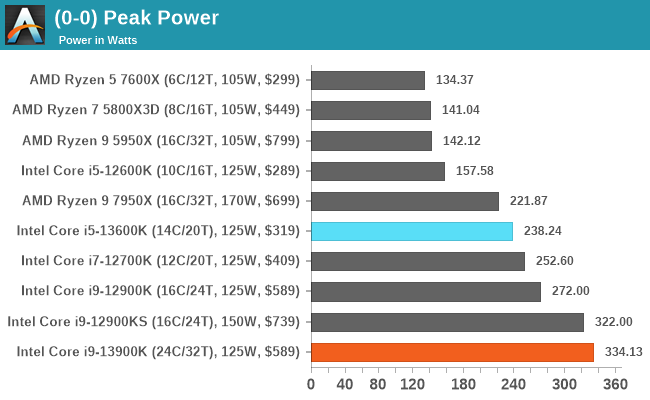
Directly digesting the peak power figures from both the Core i5-13600K and Core i9-13900K processors, the latter drew around 12 W more than the Core i9-12900KS does, and 62 W more than the regular Core i9-12900K. While additional power draw was to be expected due to the very high core clock speeds, let's not forget it is also a 24-core processor, hybrid cores or not.
Even so, the Core i9-13900K drew 32% more power than its 253 W Turbo PL2 limit, but it's very unlikely most users that are gaming or doing general PC stuff will ever see power figures like this. The key to note really with the Core i9-13900K is if it is using this power (125 W TDP to 253 W TDP = 2.02x the power) efficiently for the benefit of performance, then it makes it a less harsh pill to swallow. We would certainly recommend premium cooling with this for maximum performance efficiency.
Looking at the Core i5-13600K, this sits a bit higher than the AMD Ryzen 7950X in terms of peak power consumption, and just below the Core i7-12700K. The Core i5-13600K does draw considerably more power than its predecessor, the Core i5-12600K (157 W versus 238 W), but the increase in both core frequency and double the E-cores, is to be expected.
Looking deeper into the high power consumption of the Core i9-13900K, we can see that it is shooting above Intel's PL2 value considerably more than the previous generation. One potential reason for this is down to motherboard vendors continuing to ignore PL2 limits and optimizing for performance under a thermal limit as opposed to power.
During our testing of the AMD Ryzen 9 7950X, we saw our GIGABYTE X670E Aorus Master AM5 motherboard adhere to AMD’s PPT limit, yet with our MSI MPG Z790 Carbon WIFI, we are overshooting the 253 W PL1 limit by around 40-42% at peak figures. While we don’t believe that Intel is ignoring its own classification and specification of power limits here, we believe that the onus is on motherboard vendors to adhere to these limits. A lot of the time, motherboard manufacturers want to deliver the best possible performance out of the box it can, and while we don’t necessarily believe this is a massive negative, it does paint a picture that the Core i9-13900K has insane power draw at maximum load. A power draw that would otherwise be tempered significantly by adhering to PL2.
As we do some additional testing with the MSI MPG Z790 Carbon WIFI, we'll see if this is a specific problem with this particular motherboard, or if it’s the Z790 platform itself. We’ll also look to test some other LGA1700 models we have available, and we’ll update this analysis with our findings.
Office/Web
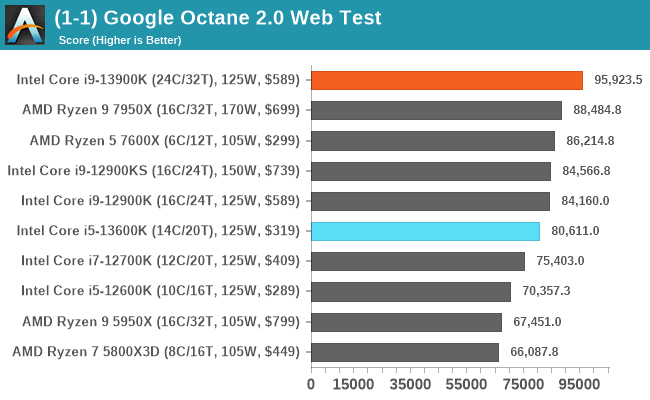
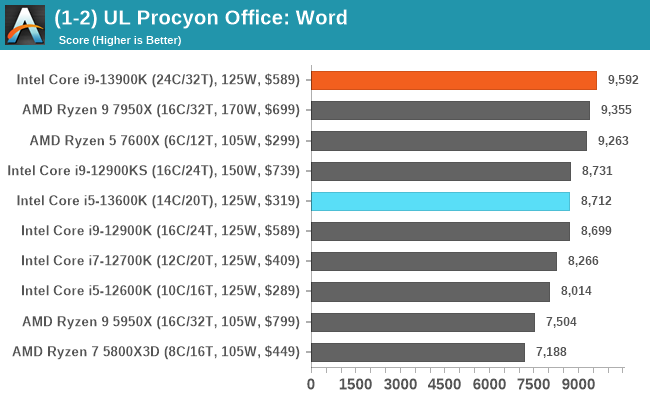
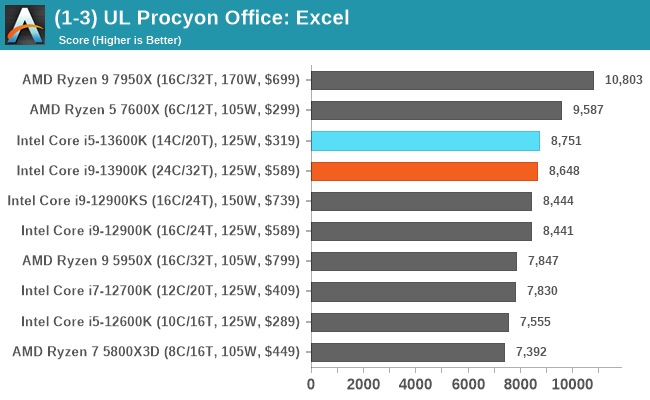
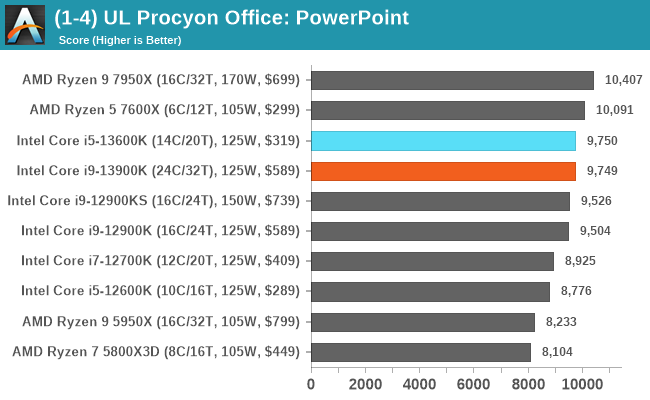

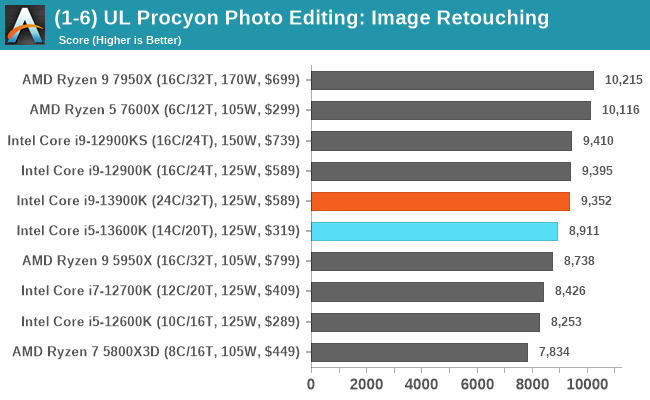
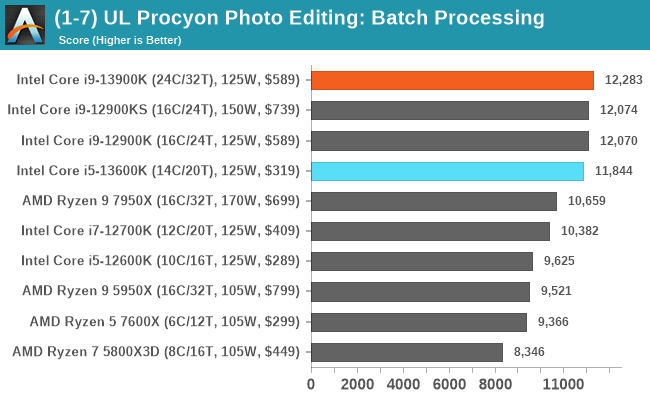
Looking at real-world web and office performance, the Core i9-13900K performs very well, and in a lot of tests, is neck and neck with the Ryzen 9 7950X. This is interesting given the Zen 4 is a new core on a new 5 nm process, and the Intel 13th Gen Core is a refined Intel 7 (10 nm) solution. The Core i5-13600K also performs competitively, and even the previous generation Core i9-12900KS are also in the thick of things.


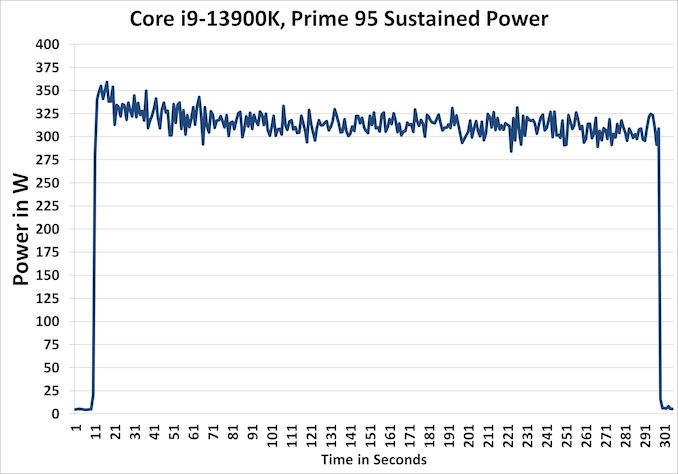








169 Comments
View All Comments
FinTechno - Saturday, October 22, 2022 - link
I don't know what is it but openbenchmarking.org gives geometric mean of all tests +20% for 7950X. In many tests 7950X kills 13900K by huge margin. Please see https://openbenchmarking.org/vs/Processor/AMD%20Ry... ReplyCT007 - Sunday, October 23, 2022 - link
So many apps that nobody uses. . . -_- ReplyCinzzano - Saturday, October 22, 2022 - link
Why would undercut all of the processors with such a piss poor RAM configuration... this is just ridiculous to pair 13th Gen Zen4 and even 12th Gen with such a slow memory and those timings...The whole review and testing are invalid. Reply
James5mith - Saturday, October 22, 2022 - link
"Whereas Alder Lake officially topped out at DDR5-4800, Alder Lake can run at DDR5-5600, helping to feed the beast a bit more with higher memory clockspeeds."Guessing the second mention should be Raptor Lake. Reply
Hrel - Sunday, October 23, 2022 - link
I really don't want any CPU over 65W Replynandnandnand - Sunday, October 23, 2022 - link
You can limit TDPs yourself. ReplyContrabondo - Friday, December 16, 2022 - link
To get performance lower than zen 3 5950x?FYI 5950x when properly tuned draws about 70-75W in Cinebench R23 at 3200MHz Reply
Archer_Legend - Sunday, October 23, 2022 - link
Nice review, however I have to say that this site has lost itself after the departure of Andrei and Ian.The deep dives on mobile processors for smartphones were very important as you were the only ones to do those and it is a real shame not to have Spec data and a detailed comparison of the A14, A15, Exynos 2100, Exynos 2200, Snapdragon 888, Snapdragon 8 gen 1, Snapdragon 8 plus gen 1, Dimensity 9000 and Dimensity 9000+.
I hope that you find and you are actively looking for a new editor for those pieces of content and that onceyou find one you push out deep dives on those SOCs even if they will not be the latest and greatest because it will complete the amazing database of reviews which stopped with 865 and those reviews where real gold! Reply
Gothmoth - Sunday, October 23, 2022 - link
good that intel is able to compete for now. but i go for the AM5 plattform.support until 2025 at least and the X 3D versions will blow intel out of the water.
i am not buying an already EOL plattform for a bit more performance. Reply
TheinsanegamerN - Monday, October 24, 2022 - link
Why not stop buying CPUs every year? It's a waste of money. Reply